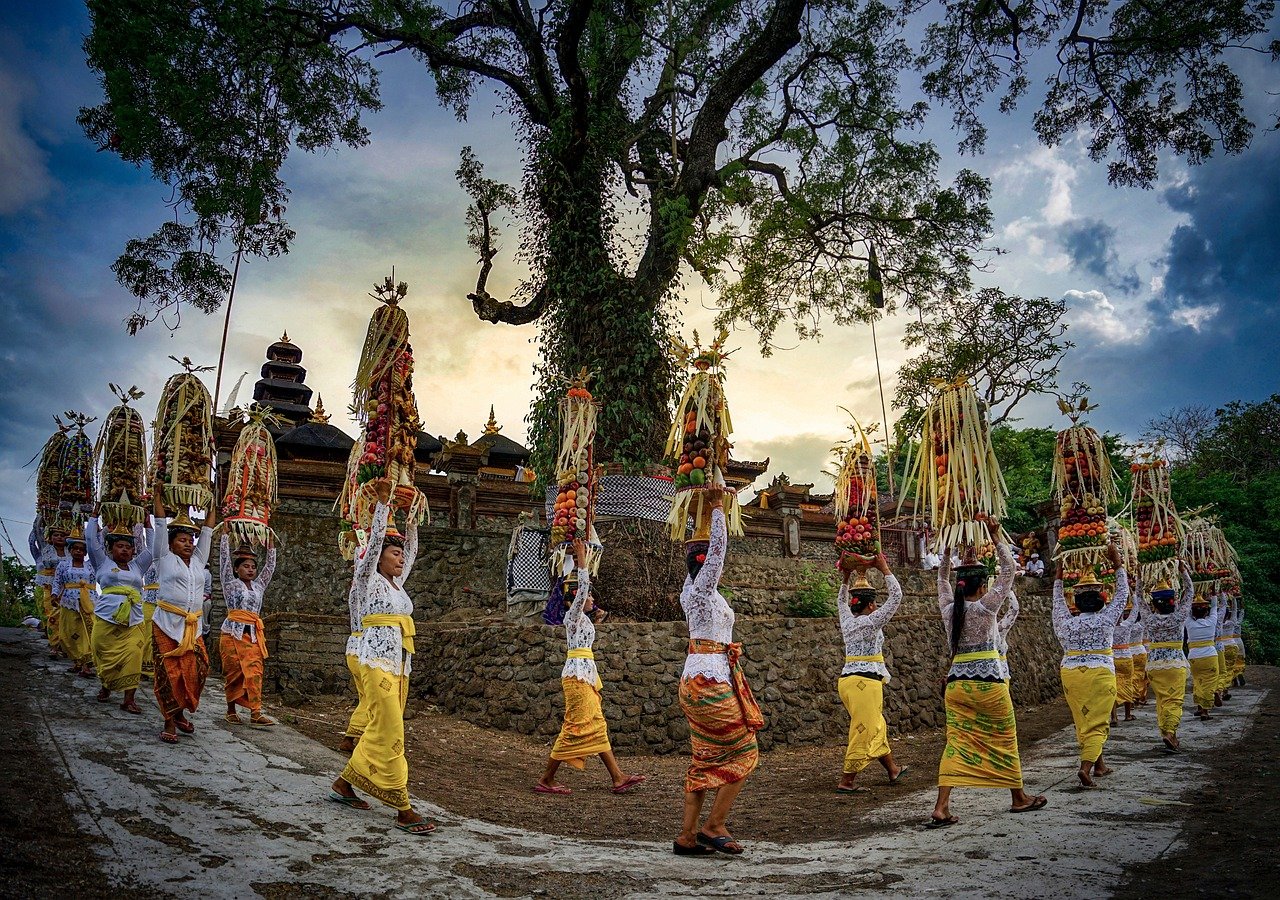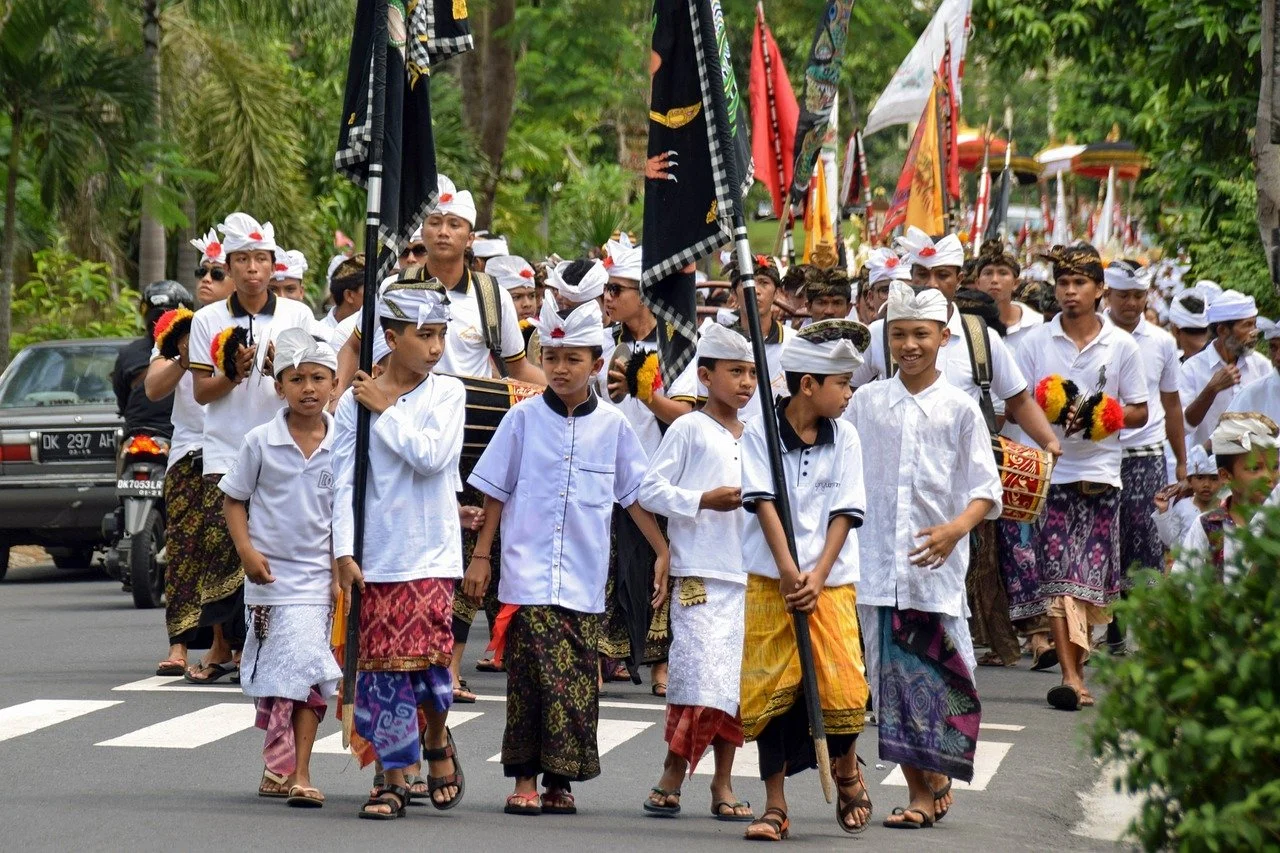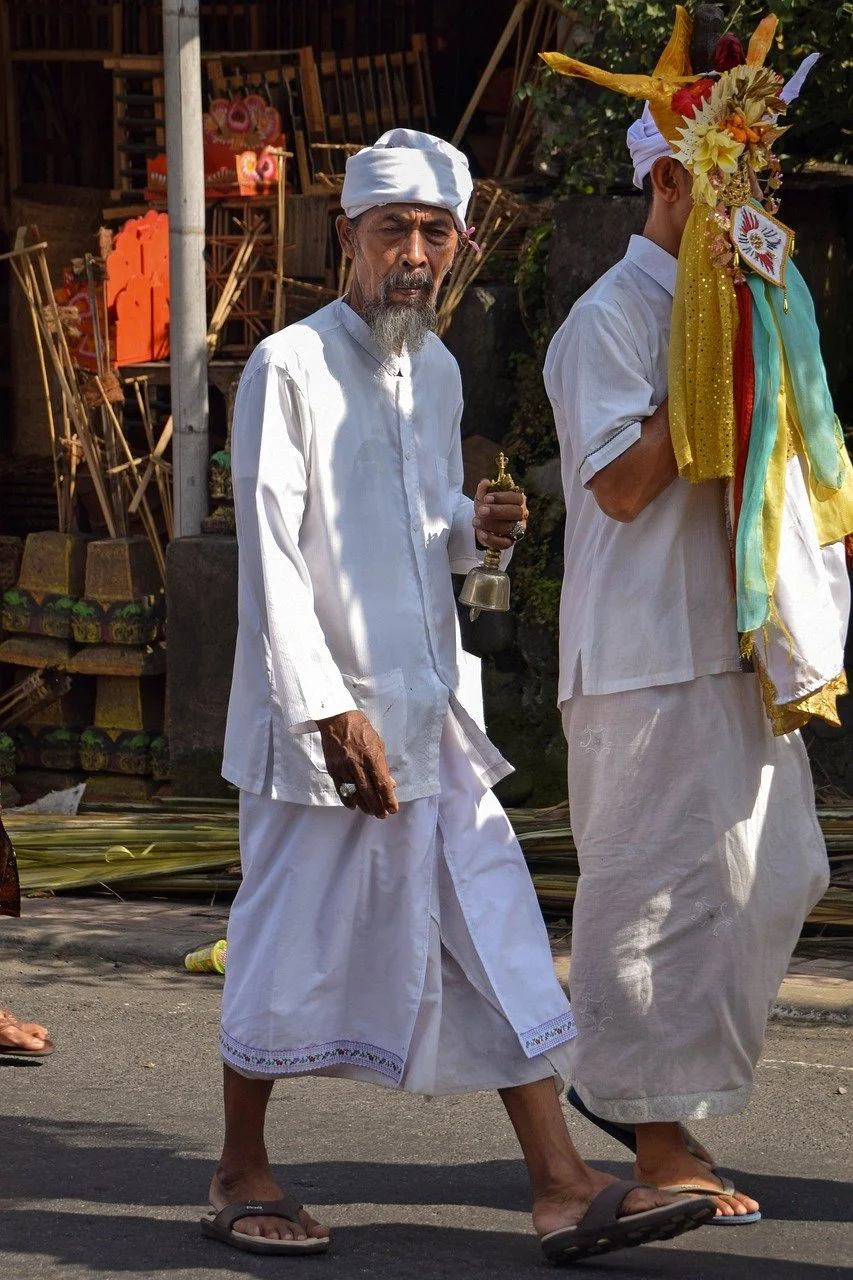An introduction to Balinese Hinduism: Origins, Rituals, and Culture
Bali’s Hindu religion embodies extraordinary beauty and immense devotion. Image by Agung Atmaja from Pixabay
Table of Contents Show
Balinese Hinduism: Origins, Rituals, and Culture
Balinese Hinduism, with its deep-rooted connection to nature and rich cultural traditions, offers a profound insight into the spiritual beliefs and practices of the Balinese people.
In this comprehensive guide, I will share the fascinating aspects of Balinese Hinduism, including its origins, rituals, deities, ceremonies, and the distinctive characteristics that set it apart from Indian Hinduism.
A cultural note for readers
This guide and its companion articles are designed to give an outsider's summary of an incredibly rich, detailed, and constantly evolving religion. It is not designed to be a definitive study but rather a ‘taste’ of the complexity of Bali’s Hindu religion and culture for visitors. All over the island, you will get slightly different stories, emphasis, and explanations because each village will have its own perspective and traditions.
The perspective in these articles is gleaned from visits over many years by Baligram’s editor, Simon St John, to one village, with one group of friends, teachers, and mentors, and is not meant to describe the whole of Bali's religion in a definitive way.
It should also be noted that even the concept of the term ‘Balinese Hinduism’ is something scholars are questioning, even today.
Free Download: Teachers Resource
You might like to download our free fact sheet on Balinese Religion to use in your classroom.
Origins and evolution of Balinese Hinduism
Indian merchants came to Bali with their Hindu beliefs
The story of Balinese Hinduism begins with the arrival of Indian merchants who brought the teachings of Hinduism to the Indonesian archipelago. However, unlike in India, where Hinduism developed as a structured religion, in Bali, it fused with the existing animistic beliefs of the local population.
This unique blend gave rise to a distinct form of Hinduism that harmoniously incorporates elements of nature worship and reverence for ancestral spirits. Balinese Hinduism has evolved over the centuries, adapting to changing times, while preserving its core values and traditions.
You can learn more about the origins of Balinese Hinduism in our article 'Exploring the Indian Hindu origins of the Balinese Religion'
The essence of Balinese Hinduism
At the heart of Balinese Hinduism lies a deep reverence for nature and a belief in the interconnectedness of all living beings. The Balinese view the world as a delicate balance between the forces of light and shadow, good and bad, which coexist harmoniously.
The Balinese understand that both aspects are integral parts of existence and embrace the concept of duality with grace and acceptance. This philosophy permeates every aspect of their lives, from daily offerings to grand ceremonies, as they strive to find harmony and balance in all situations.
Deities of Balinese Hinduism
From an early age, Bali’s children learn about the gods and goddesses that serve and protect them.
In Balinese Hinduism, a pantheon of gods and goddesses is worshipped, each representing different aspects of nature and life.
The Balinese believe that these deities reside in temples and shrines scattered throughout the island. Among the most revered deities are Sang Hyang Widhi Wasa, the supreme god, and the Trimurti, consisting of Brahma (the creator), Vishnu (the preserver), and Shiva (the destroyer).
Other important deities include Dewi Sri, the goddess of rice and fertility, and Saraswati, the goddess of knowledge and arts. Each deity has their own ceremonies, rituals, and temples dedicated to their worship.
Other topics to explore in our Balinese Religion series:
Orientation and Its significance to Balinese spirituality
The Balinese use celestial alignment to understand direction. They see themselves as part of the cosmos, mirroring its structure. By following these connected directions, the Balinese seek balance and harmony in their lives.
To indicate places and give guidance, the Balinese use cardinal directions rather than terms like "left" or "right." This practice highlights the importance of orientation in their culture and strengthens their connection to the environment.
You might like to read more in our article, ‘Orientation and Its Significance to Balinese Spirituality’.
Rituals and ceremonies
Balinese Hinduism is renowned for its elaborate and colorful ceremonies that punctuate the island's calendar year. These ceremonies range from daily rituals performed within households to large-scale village festivals that attract locals and tourists alike. The Balinese celebrate various milestones in life, such as childbirth, coming of age, marriage, and death, with unique rituals that reflect their spiritual beliefs and cultural heritage.
These ceremonies often involve vibrant processions, traditional dances, intricate offerings, and the recitation of sacred mantras, creating a mesmerizing spectacle that showcases the depth of Balinese devotion.
Discover the key ceremonial days in Bali and their significance and meaning in our article, ‘Significant ceremonial days in the Balinese Calendar’.
You can also find out more about the beautiful and intricate Balinese offerings in our article, ‘The Significance of Offerings in Balinese Religion’.
The importance of holy water
One of the key elements of every ceremony, from the most humble household temple to the Mother Temple Besakih, is that of holy water.
You can learn more about the importance of Balinese holy water in our article, ‘The Significance of Holy Water in Balinese Religion’.
Balinese Hindu priests and holy figures
A crucial aspect of Balinese Hinduism is the role of priests and holy figures who serve as guardians and custodians of the religion. Balinese Hindu priests, known as Pedanda and, lay-priests, known as Pemangku, are responsible for conducting rituals, leading ceremonies, and maintaining the sanctity of temples. They are highly respected and regarded as intermediaries between the human and spiritual realms. Other holy figures, such as Pedanda, Balian, Rsi, and Dukun, also play significant roles in Balinese Hinduism, each contributing to the spiritual well-being of the community in their unique ways.
Bali’s Pedandas and the role of mysticism in Hindu Bali relgion
Balinese priests safeguard ancient traditions and integrate mysticism into everyday life and religious rituals
In her article, ‘Mysticism among the Pedandas of Bali’, author June E McDaniel examines the role of the pedandas, also known as brahmin high priests, who hold significant religious authority in Bali.
These religious leaders safeguard the ancient traditions of Indonesian Hinduism, opposing the influence of Westernisation and modernisation.
The Pedandas are the traditional Hindu religious leaders in Bali, and their role involves integrating mysticism into their daily lives and religious rituals.
The Pedandas emphasise ethical behavior and serve the community by mystically uniting with the god Shiva. They place a strong emphasis on serving the community and upholding ethical standards. According to June E McDaniel, this dedication to ethical behavior sets them apart from many contemporary religions, where the mystical side has diminished due to economic and political concerns.
The Pedandas also engage in trance states and mystical experiences. Trance, known as kerauhan in the local language, is a prominent form of religious experience in Bali. It occurs during yadnya ceremonies of worship and offering to the gods. Trance is considered a human link between the physical and divine worlds, making it a mystical or semi-mystical experience.
Furthermore, the Pedandas are deeply connected to the Balinese Hindu tradition and its mystical aspects. They maintain the custom of creating holy water, which is essential for religious rituals. This holy water is believed to possess spiritual power and is used for purification and blessings. The Pedandas play a crucial role in the creation of this holy water, making them central figures in the mystical practices of Balinese Hinduism.
The caste and clan system in Bali
Caste refers to the hereditary classes of Hindu society, distinguished by relative degrees of ritual purity and social status.
In Bali, caste still holds significance, although the Indonesian government has officially banned discrimination based on caste. Balinese people often inquire about one's caste upon meeting, as it helps determine social interactions and codes of deference. Caste prerogatives are maintained, and individuals tend to associate more freely with those of their own caste.
Discover more about the Balinese caste and clan system in our article, ‘The Fascinating Caste and Clan System in Balinese Religion’.
Sacred temples of Bali
A procession to one of Bali’s many seaside temples. Image by hartono subagio from Pixabay
Bali is home to thousands of temples, each with its own significance and purpose. These temples, known as puras, serve as spiritual sanctuaries and places of worship for the Balinese Hindu community. The architecture of Balinese temples is influenced by Indian temple design, characterized by intricately carved stone structures and towering gateways. The temples are often set amidst lush landscapes, offering a serene and tranquil atmosphere for devotees and visitors.
Some of the most iconic temples in Bali include Tanah Lot, Besakih, and Uluwatu, each with its own unique charm and spiritual aura.
Most visitors to Bali will try to visit at least one temple to connect with the spiritual heart of Bali.
You might like our detailed guide to Bali temples to inspire your journey of discovery.
The temple odalan
Every temple in Bali, from the smallest household temple to Besakih, Bali’s mother temple, must have an ‘odalan’ ceremony every 210 days. If you ask around during your stay, you are sure to find a hotel staff member, taxi driver, waitress, or new-found friend on the street who is having an odalan in their home or village’s temple. If you ask, you will be made most welcome to attend and learn about this incredible ceremony. You can find out more in our article, ‘Understanding the Odalan: A Vibrant Balinese Temple Festival’.
Major Balinese Hindu ceremonies and the Balinese calendar
The Balinese calendar is brimming with significant religious events and ceremonies that celebrate various deities and honor ancestral spirits. These ceremonies are an integral part of Balinese Hinduism, showcasing the deep devotion and cultural pride of the Balinese people.
Some of the most important ceremonies include Galungan and Kuningan, which commemorate the victory of good over evil, and Nyepi, the Balinese New Year, when the island falls into complete silence and reflection. Saraswati Puja, a celebration dedicated to the goddess of knowledge and arts, and Siwaratri, a night of fasting and meditation in honor of Lord Shiva, are also widely observed throughout Bali.
Dive deeper into the unique Balinese calendar and discover how it is actually three calendars in one in our article, ‘The Balinese Calendar and how it guides everyday life in Bali’.
Balinese Hinduism and daily life
Balinese Hinduism is not just limited to grand ceremonies and temple rituals; it permeates every aspect of daily life for the Balinese people. From the crack of dawn, the island comes alive with the sound of prayers, as households prepare offerings and perform rituals to honor their ancestors and seek blessings for the day.
The Balinese practice a deep sense of gratitude for the bounties of nature and engage in acts of devotion throughout the day. This harmonious integration of religion and daily life is a testament to the profound influence that Balinese Hinduism has on the cultural fabric of Bali.
Every household in Bali has its own temples, and you can find out more about them in our article, ‘Household Shrines: Exploring the Spiritual World of Balinese Homes’.
Balinese Hinduism and tourism
Tourism has played a significant role in the preservation and promotion of Balinese Hinduism. The influx of visitors from around the world has brought a renewed appreciation for the island's rich cultural heritage and religious practices.
Travelers have the opportunity to witness and participate in ceremonies, visit temples, and gain insights into the spiritual beliefs of the Balinese people. This exchange of cultures and ideas fosters mutual understanding and respect, further enriching the tapestry of Balinese Hinduism.
The future of Balinese Hinduism
A Bali family navigates the streets of culture, religion, and modernity. Image by Martin Fuhrmann from Pixabay
As Bali continues to evolve and modernize, the future of Balinese Hinduism faces both challenges and opportunities. The Balinese people strive to maintain the essence of their religious traditions while embracing the changes brought by globalization.
Efforts are being made to ensure the continuity of rituals and ceremonies, the preservation of sacred sites, and the passing on of knowledge to future generations. Balinese Hinduism remains a vibrant and integral part of Balinese identity, a testament to the resilience and spiritual depth of the Balinese people.
Conclusion
Balinese Hinduism is a tapestry of spirituality, culture, and devotion that captivates the hearts of those who experience it. Its unique blend of Indian Hinduism and indigenous animistic beliefs creates a vibrant and inclusive form of worship that celebrates the natural world and ancestral spirits.
The ceremonies, temples, rituals, and holy figures of Balinese Hinduism offer a profound journey into the soul of Bali, inviting visitors to connect with a centuries-old heritage and immerse themselves in the warmth and beauty of Balinese culture.
Whether you are a traveler seeking spiritual enlightenment or a cultural enthusiast eager to explore the depths of human spirituality, Balinese Hinduism promises an unforgettable experience that will leave an indelible mark on your heart and soul.
Sources and further reading
This very brief introduction is designed to give a ‘bird's eye view’ for visitors to Bali who are looking to get a feel for the religious significance of the culture they witness during their holiday.
If you would like to explore Balinese religion in more detail, check out these sources, which were used in our research for the set of articles on Baligram:
SOURCES:
Bali: Sekala & Niskala: Essays on Religion, Ritual, and Art, Fred B. Eiseman, Jr. (A highly recommended book if you want a detailed insight into the religion, culture and art of Bali, affiliate link).
Indian Influences on Balinese Culture : The Role of Hinduism and Buddhism in Present Day Bali, Ipang Wijaya, International Research Journal of Management, IT & Social Sciences.
Balinese religion in search of recognition: From Agama Hindu Bali to Agama Hindu (1945-1965), Michel Picard, 2011, Bijdragen tot de taal-, land- en volkenkunde / Journal of the Humanities and Social Sciences of Southeast Asia.
Mysticism among the Pedandas of Bali, June E McDaniel, MDPI AG.
Hindu Culture in Indonesia, Rekha Rao.
Frequently asked questions about the Balinese Hindu religion
What are the key beliefs of the Balinese Hindu religion?
The Balinese Hindu religion is characterized by a belief in the existence of a supreme deity called Sang Hyang Widhi Wasa, as well as a pantheon of gods and goddesses. It also emphasizes the concept of karma and the cycle of birth, death, and rebirth.
How does the Balinese Hindu religion shape daily life in Bali?
The Balinese Hindu religion shapes daily life in Bali through the observance of rituals, ceremonies, and offerings. It influences social interactions, family dynamics, and community engagement, providing a framework for moral and ethical behavior.
What is the role of temples in Balinese Hinduism?
Temples hold great significance in Balinese Hinduism as places of worship and spiritual connection. They serve as communal gathering spaces for religious ceremonies, rituals, and festivals, fostering a sense of community and devotion.
How do offerings play a role in Balinese Hinduism?
Offerings, known as canang sari, are an integral part of Balinese Hinduism. They are made daily and placed in homes, temples, and other sacred spaces as a gesture of gratitude and devotion to the deities. Offerings symbolize the Balinese belief in maintaining harmony and balance between the physical and spiritual realms.
What are some of the major festivals and ceremonies in Balinese Hinduism?
Balinese Hinduism celebrates a multitude of festivals and ceremonies throughout the year. Some notable ones include Galungan, Nyepi (Day of Silence), Saraswati, and Kuningan. These festivals are marked by vibrant processions, rituals, and cultural performances.
How does the Balinese Hindu religion promote environmental stewardship?
The Balinese Hindu religion promotes environmental stewardship through its belief in the sacredness of nature. Balinese Hindus view the natural world as interconnected with the divine and strive to maintain ecological balance and harmony in their daily lives and rituals.
How does the Balinese Hindu religion foster a sense of community and social cohesion?
The Balinese Hindu religion fosters a sense of community and social cohesion through collective participation in religious ceremonies and rituals. These communal activities strengthen social bonds, reinforce cultural identity, and promote a shared sense of belonging among the Balinese people.
What is the role of priests in Balinese Hinduism?
Priests, known as pemangku, play a crucial role in Balinese Hinduism. They are responsible for conducting rituals, performing ceremonies, and providing spiritual guidance to the community. They are highly respected and considered as intermediaries between the divine and the people.
How does the Balinese Hindu religion influence art and aesthetics in Bali?
The Balinese Hindu religion has a profound influence on art and aesthetics in Bali. It inspires various art forms such as traditional dance, music, painting, and sculpture, which often depict Hindu mythological stories and themes. The religious rituals and ceremonies also incorporate artistic elements, creating a rich visual and sensory experience.
How has the Balinese Hindu religion adapted and evolved over time?
The Balinese Hindu religion has adapted and evolved over time, incorporating local customs, beliefs, and practices. It has assimilated elements from indigenous Balinese animism and ancestor worship, resulting in a unique form of Hinduism specific to Bali. This adaptability has allowed the religion to thrive and remain deeply ingrained in Balinese culture and daily life.



























Bali's remarkable rice terraces draw numerous tourists. However, could tourism pose a threat that the age-old Subak system might struggle to overcome?